Microsoft dynamics CRM 2011 reporting
Bạn đang xem bản rút gọn của tài liệu. Xem và tải ngay bản đầy đủ của tài liệu tại đây (23.08 MB, 308 trang )
www.it-ebooks.info
Microsoft Dynamics CRM
2011 Reporting
Everything you need to know to work with reports
in Dynamics CRM 2011
Damian Sinay
BIRMINGHAM - MUMBAI
www.it-ebooks.info
Microsoft Dynamics CRM 2011 Reporting
Copyright © 2013 Packt Publishing
All rights reserved. No part of this book may be reproduced, stored in a retrieval
system, or transmitted in any form or by any means, without the prior written
permission of the publisher, except in the case of brief quotations embedded in
critical articles or reviews.
Every effort has been made in the preparation of this book to ensure the accuracy
of the information presented. However, the information contained in this book is
sold without warranty, either express or implied. Neither the author, nor Packt
Publishing, and its dealers and distributors will be held liable for any damages
caused or alleged to be caused directly or indirectly by this book.
Packt Publishing has endeavored to provide trademark information about all of the
companies and products mentioned in this book by the appropriate use of capitals.
However, Packt Publishing cannot guarantee the accuracy of this information.
First published: June 2013
Production Reference: 1180613
Published by Packt Publishing Ltd.
Livery Place
35 Livery Street
Birmingham B3 2PB, UK.
ISBN 978-1-84968-230-5
www.packtpub.com
Cover Image by Sandeep Babu ()
www.it-ebooks.info
Credits
Author
Copy Editors
Damian Sinay
Insiya Morbiwala
Aditya Nair
Reviewers
Alfida Paiva
Nishant Rana
Laxmi Subramanian
James Wood
Project Coordinator
Acquisition Editor
Leena Purkait
Vinay Argekar
Commissioning Editor
Shreerang Deshpande
Lead Technical Editor
Mayur Hule
Proofreaders
Aaron Nash
Paul Hindle
Indexer
Tejal R. Soni
Technical Editors
Graphics
Sharvari Baet
Abhinash Sahu
Jeeten Handu
Veena Pagare
Production Coordinator
Akshata Patil
Conidon Miranda
Kaustubh S. Mayekar
Cover Work
Conidon Miranda
www.it-ebooks.info
About the Author
Damian Sinay has over 15 years experience in the software development and IT
industry. He started working with the .NET framework when its first Version 1.0
was in the beta stage. In 2002, he won first prize in the "Building solutions based
on XML Web Services" contest, which spanned across Latin America, by Microsoft.
In 2006, he wrote his first book in his native language (Spanish) on web services
with C# development.
He started working with CRM solutions prior to the first release of Microsoft
Dynamics CRM's initial version. Since then, he has exclusively been developing
and implementing solutions for Dynamics CRM and SharePoint. He is certified in
Versions 3.0, 4.0, and 2011 including development, installation, configuration, and
implementation of Dynamics CRM. He has around 18 Microsoft certifications (MCP)
in SQL, C#, ASP.NET, TFS, Project, CRM, and SharePoint 2007 and 2010. Among
many other things, he has co-authored the Dynamics CRM unleashed books for
Versions 4.0 and 2011.
He held the Microsoft Most Valuable Professional (MVP) award in Dynamics CRM
in 2012 and serves as the CEO of Remoting Coders, a Microsoft Partner company
that is turning 10 years old in 2013, providing solutions using Microsoft products
and technologies.
You can contact Damian at , follow him on Twitter at
@damiansinay, and can also read the blog at />Blogsite/.
I would like to especially thank my wife Carina Godoy de Sinay and
my kids who have been positive and unconditional supporters.
I would also like to thank my clients, my colleagues, Microsoft
MVPs, the Microsoft CRM product team, and my partners who have
provided invaluable opportunities for me to expand my knowledge
and shape my career.
www.it-ebooks.info
About the Reviewers
Nishant Rana currently works at Microsoft Services Global Delivery (MSGD). He
has done his specialization in the Microsoft .NET technology and has been actively
involved with it since its release. His main focus area has been Microsoft Dynamics
CRM and SharePoint. He is a Microsoft Certified Technology Specialist and an IT
professional in Dynamics and SharePoint, and a MCAD (Application Developer)
for .NET.
He has also reviewed the book entitled Microsoft Dynamics CRM 2011 Application
Design, Mahendar Pal, Packt Publishing.
You can contact Nishant via his website or Twitter account:
/> />
I would like to thank my family and my friends for their love, care,
and support.
www.it-ebooks.info
James Wood is a consultant at Gap Consulting with skills in the end-to-end
implementation of enterprise-level Microsoft Dynamics CRM solutions. He
graduated from the University of Huddersfield with a First Class degree in
Computer Games Programming before making the switch to business applications.
He has worked with Microsoft Dynamics CRM for three years and is an able
developer of bespoke applications. He has worked on a number of small to large
implementations in sectors including local and regional government, education,
defense, banking, manufacturing, and welfare.
He has also worked as a technical reviewer for Microsoft Dynamics CRM 2011
Application Design and Microsoft Dynamics CRM 2011: An expert cookbook for securing,
customizing, and extending your CRM apps.
You can read his blog at www.woodsworkblog.wordpress.com.
I would like to thank my family and friends for everything—especially
Mum, Dad, Rob, and Chloё.
www.it-ebooks.info
www.PacktPub.com
Support files, eBooks, discount offers and
more
You might want to visit www.PacktPub.com for support files and downloads related to your book.
Did you know that Packt offers eBook versions of every book published, with PDF and ePub files
available? You can upgrade to the eBook version at www.PacktPub.com and as a print book
customer, you are entitled to a discount on the eBook copy. Get in touch with us at service@
packtpub.com for more details.
At www.PacktPub.com, you can also read a collection of free technical articles, sign up for a range
of free newsletters and receive exclusive discounts and offers on Packt books and eBooks.
TM
Do you need instant solutions to your IT questions? PacktLib is Packt's online digital book library.
Here, you can access, read and search across Packt's entire library of books.
Why Subscribe?
•
Fully searchable across every book published by Packt
•
Copy and paste, print and bookmark content
•
On demand and accessible via web browser
Free Access for Packt account holders
If you have an account with Packt at www.PacktPub.com, you can use this to access PacktLib
today and view nine entirely free books. Simply use your login credentials for immediate access.
Instant Updates on New Packt Books
Get notified! Find out when new books are published by following @PacktEnterprise on Twitter,
or the Packt Enterprise Facebook page.
www.it-ebooks.info
www.it-ebooks.info
Table of Contents
Preface1
Chapter 1: Introduction to Reporting in Microsoft Dynamics CRM 7
CRM report types
7
CRM report settings
8
Categories10
Related Record Types
12
Display in
14
Languages14
SQL reporting services versions
14
SQL Server databases
16
Windows Service
17
Report Manager website
17
Report Server Web service
17
Installation and configuration of Reporting Services Extensions
17
Installation and configuration of Report Authoring Extension
(Visual Studio development)
24
Summary30
Chapter 2: Database Basics
31
One-to-many relationships (1:N)
Many-to-one relationships (N:1)
Many-to-many relationships (N:N)
34
36
37
ERD basics
Relationship types
31
33
SQL overview
38
Select38
Update41
www.it-ebooks.info
Table of Contents
Delete41
Insert41
WHERE42
ORDER BY
43
group by
44
join46
SQL advanced
47
CREATE TABLE
48
DROP TABLE
48
Stored procedures
48
Cursors50
Transactions52
FetchXML overview
52
Select fields
59
Filters and conditions
61
Order by
62
Group by
63
Linking to other entities
64
Inner join
Outer join
64
64
Summary65
Chapter 3: Creating Your First Report in CRM
67
Chapter 4: SQL Server Report Builder
93
Using Microsoft Dynamics CRM 2011 Report Wizard
67
Using Visual Studio
80
Publishing the report
91
Summary92
Report Builder overview
93
Datasets96
Query Designer
101
Creating a new report
103
Table or Matrix Wizard
104
Adding a logo to our report
113
Advanced reports with Report Builder
118
Map Wizard
119
Map visualization types
122
Testing the Map report
125
The Report Builder's limitations
126
Summary126
[ ii ]
www.it-ebooks.info
Table of Contents
Chapter 5: Creating Contextual Reports
127
Chapter 6: Creating Inline Reports
163
Chapter 7: Using Reports and Charts in Dashboard
187
Using Visual Studio
127
Toolbox
129
Expressions131
Prefilters
132
Report parameters in detail
133
CRM_FilterText133
CRM_FormatDate133
CRM_FormatTime134
CRM_FullName134
CRM_FilteredAccount134
CRM_URL135
CRM_CalendarType135
Data sources
137
Embedded data sources
138
Shared data sources
139
Data sets
143
Groups on data sets
151
Adding columns to the report
151
Hiding and showing columns
153
Charts157
Drill-down and collapsible controls
160
Summary161
Embedding reports on an entity form
163
Creating a custom solution
165
Creating the HTML web resource
166
Implementing the report control
171
Developer Toolkit
176
Summary185
Showing report on a dashboard
187
Exporting dashboards
191
Basic charts
193
Drill-down chart
196
Charts editor
199
Exporting charts
204
Charts internals
208
3D charts
209
Summary210
[ iii ]
www.it-ebooks.info
Table of Contents
Chapter 8: Advance Custom Reporting and Automation
211
Chapter 9: Failure Recovery and Best Practices
241
Chapter 10: Mobile Client
259
Appendix: Expression Snippets
275
The ASP.NET report
211
Late binding
213
Early binding
219
CRM integration
222
Silverlight reports
222
MVVM223
Basic report automation
226
Report scheduling
227
Advanced report automation (programmatically)
234
Summary239
Common failures in SSR authentication
241
Tracing242
Enabling CRM Trace
243
Using SQL Trace
246
Report development best practices
251
Report deployment best practices
252
Improving the performance of reports
253
Creating report caching
253
Creating report snapshots
257
Summary258
New features for mobile clients
259
The sales process
262
The autosave feature
264
SQL Server 2012 with SP1
267
Microsoft Surface
270
The mobile client's considerations
270
Authentication considerations
271
Custom reports development considerations
273
Summary273
Basic expressions
275
Constants277
Variables278
[ iv ]
www.it-ebooks.info
Table of Contents
Advanced expressions with VBScript code
279
References280
Working with control events
281
Actions282
Visibility282
Interactive Sorting
283
Summary284
Index285
[v]
www.it-ebooks.info
www.it-ebooks.info
Preface
Microsoft Dynamics CRM 2011 Reporting is a practical reference guide that provides
you with a number of different options you can use to create and empower the
reporting capabilities of Dynamics CRM. This will give you a good grounding
for using the reports in your Dynamics CRM 2011 implementations.
What this book covers
Chapter 1, Introduction to Reporting in Microsoft Dynamics CRM explains the different
types of reports we can use in Dynamics CRM. Further, it explains SQL Server
Reporting Services (SSRS) and how to install the Dynamics CRM 2011 Extensions.
It also covers how to install the Microsoft Dynamics CRM 2011 Report Authoring
Extension, which we are going to use and explain later in this book.
Chapter 2, Database Basics explains the entity-relationship model of Dynamics CRM;
we will review the basic and advanced commands of the SQL language as well as
the FETCH XML language that we will need to use in order to create the queries
we will use in our reports. We are going to keep using these two languages in the
following chapters.
Chapter 3, Creating Your First Report in CRM helps us to create our first report using
the Report Wizard and also to export the report to be edited with Visual Studio 2008,
where we will make some customizations to reupload the report in Dynamics CRM.
We will also see how to publish the report to be visible on the Reporting Server
manager for external use.
Chapter 4, SQL Server Report Builder helps us to create our first report using the Report
Builder and shows us the features we can use that were not available in the standard
CRM Report Wizard. We will also create an advanced report using the Map Wizard,
where we will show the records held by the USA.
www.it-ebooks.info
Preface
Chapter 5, Creating Contextual Reports explains the advanced tools and controls
we can use to create reports with Visual Studio. We will review the CRM Report
parameters and the chart controls. This chapter explains the differences between
the data source and datasets, and finally looks at how to use the groups, drill-down
and collapsible controls in reports.
Chapter 6, Creating Inline Reports shows us how we can embed a report inside any
entity form by creating a custom solution that uses an HTML web resource. We
will also see how to implement this custom solution on the account entity using the
account overview report. We will then review the development toolkit, which will
help us work in a more organized manner with custom CRM solutions to get the
benefit of IntelliSense. The deployment capability also allows us to integrate our
source code with a source controller software, such as the Team Foundation server.
Chapter 7, Using Reports and Charts in Dashboard shows us how we can integrate a
report in a CRM Dashboard and explains the chart basics as well as more advanced
details; this is always a good option to display important information about the
CRM system if we don't want to use reports.
Chapter 8, Advance Custom Reporting and Automation shows us how we can integrate a
custom ASP.NET or Silverlight application to show a dynamic or more sophisticated
report inside Dynamics CRM 2011. We will look at the different ways to bind CRM
data by using early or late binding methods, and finally we will look at some ways
to automate SSRS reports by either using scheduling or by automating export report
generation with code.
Chapter 9, Failure Recovery and Best Practices shows us how we can troubleshoot
different authentication issues we might face when working with reports in Dynamics
CRM, as well as the different ways to improve the report development performance
and deployment by using some of the best practices for SQL Reporting Services.
Chapter 10, Mobile Client shows us the new features of Dynamics CRM and SQL
Server 2012 to show and run reports on mobile devices, such as iPhone, iPad, and
Surface. We will look at how to configure the IFD authentication so we can give
external users access to our on-premise CRM environment.
Appendix, Expression Snippets shows us some basic expressions and how we can use
them in our reports; we will learn how to use constants, variables, and functions, as
well as using external .NET assemblies by using the references. Finally, we will look
at the user interaction controls that will help us interact with the users.
[2]
www.it-ebooks.info
Preface
What you need for this book
• Windows Server Standard Edition 2008 R2 or 2012
• SQL Server 2012 with SP1/2008 R2 with SP2
• Visual Studio 2008/2010 installed by the SQL Server development tools
• Dynamics CRM 2011 with RU 13 and/or CRM Online
• Visual Studio 2012 for custom reports in ASP.NET and Silverlight
Who this book is for
This book is an indispensable guide for users and developers new to Dynamics
CRM Reports and SQL Server Reporting Services, and who are looking to get a
good grounding in using the reporting capabilities of Dynamics CRM 2011. It's
assumed that you will already have some experience in HTML and JavaScript to
build advanced reports, but no previous programming experience is required to
build and learn how to create some basic to intermediate reports, which will be
used for the exercises within this book.
Conventions
In this book, you will find a number of styles of text that distinguish between
different kinds of information. Here are some examples of these styles, and an
explanation of their meaning.
Code words in text are shown as follows: "To group you add the aggregate='true'
attribute to the fetch node."
A block of code is set as follows:
<fetch version="1.0" mapping="logical" distinct="false">
<entity name="account">
<attribute name="telephone1" />
</entity>
</fetch>
When we wish to draw your attention to a particular part of a code block, the
relevant lines or items are set in bold:
DataTable accounts = new DataTable("Accounts");
accounts.Columns.Add("name");
accounts.Columns.Add("accountid");
string fetchQuery = @"
<fetch distinct='false' mapping='logical' >
[3]
www.it-ebooks.info
Preface
Any command-line input or output is written as follows:
declare @name as varchar(160)
declare @revenue as money
New terms and important words are shown in bold. Words that you see on the
screen, in menus or dialog boxes for example, appear in the text like this: "Check
the checkbox that says I accept this license agreement and click on I Accept
to continue".
Warnings or important notes appear in a box like this.
Tips and tricks appear like this.
Reader feedback
Feedback from our readers is always welcome. Let us know what you think about
this book—what you liked or may have disliked. Reader feedback is important for
us to develop titles that you really get the most out of.
To send us general feedback, simply send an e-mail to ,
and mention the book title via the subject of your message.
If there is a topic that you have expertise in and you are interested in either writing
or contributing to a book, see our author guide on www.packtpub.com/authors.
Customer support
Now that you are the proud owner of a Packt book, we have a number of things
to help you to get the most from your purchase.
Downloading the example code
You can download the example code files for all Packt books you have purchased
from your account at . If you purchased this book
elsewhere, you can visit and register to
have the files e-mailed directly to you.
[4]
www.it-ebooks.info
Preface
Errata
Although we have taken every care to ensure the accuracy of our content, mistakes
do happen. If you find a mistake in one of our books—maybe a mistake in the text or
the code—we would be grateful if you would report this to us. By doing so, you can
save other readers from frustration and help us improve subsequent versions of this
book. If you find any errata, please report them by visiting ktpub.
com/submit-errata, selecting your book, clicking on the errata submission form link,
and entering the details of your errata. Once your errata are verified, your submission
will be accepted and the errata will be uploaded on our website, or added to any list of
existing errata, under the Errata section of that title. Any existing errata can be viewed
by selecting your title from />
Piracy
Piracy of copyright material on the Internet is an ongoing problem across all media.
At Packt, we take the protection of our copyright and licenses very seriously.
If you come across any illegal copies of our works, in any form, on the Internet,
please provide us with the location address or website name immediately so
that we can pursue a remedy.
Please contact us at with a link to the suspected
pirated material.
We appreciate your help in protecting our authors, and our ability to bring
you valuable content.
Questions
You can contact us at if you are having a problem
with any aspect of the book, and we will do our best to address it.
[5]
www.it-ebooks.info
www.it-ebooks.info
Introduction to Reporting in
Microsoft Dynamics CRM
Microsoft Dynamics CRM 2011 makes extensive use of reporting, which we will be
covering through this entire book. Reporting is a very important piece of any system
that is heavily used by managers or upper management roles, such as the CEO and
COO, of any enterprise. In this chapter we will cover:
• CRM report types
• CRM report settings
• SQL Reporting Services versions
• Installation and configuration of Reporting Services Extension
• Installation and configuration of Report Authoring Extension
(used for Visual Studio development)
CRM report types
Microsoft Dynamics CRM 2011 allows different types of reports; not only can the
SQL Reporting Services reports be used, but other custom reports, such as Crystal
Reports, ASP.NET, or Silverlight reports can also be integrated.
Dynamics CRM can manage the following types of reports:
• RDL files, which are SQL Reporting Services reports
• External links to external applications such as Crystal Reports, ASP.NET,
or Silverlight reports
• Native CRM dashboards with charts
www.it-ebooks.info
Introduction to Reporting in Microsoft Dynamics CRM
The RDL files can be created in either of the following two ways:
• By using the Report Wizard
• By using Visual Studio
Dynamics CRM 2011 comes with 54 predefined reports out of the box; 25 of them
are main reports and 29 are subreports. If for some reason you don't see any report
as shown in the following screenshot, it means Dynamics CRM 2011 Reporting
Extensions were not installed. This is something that can only happen for on-premise
environments; if you are working with CRM Online, you don't need to be worried
about any report-extension-deployment tasks.
CRM report settings
Reports in Dynamics CRM have the following settings or categories that
you can access by clicking on the Edit button of each report, as shown in
the following screenshot:
[8]
www.it-ebooks.info
Chapter 1
In the Report: Account Summary window you will see two tabs, General
and Administration.
The Administration tab will show the name of the owner of the report, when
the report was created or updated and who did it, and whether it is viewable
to the user or the entire organization.
[9]
www.it-ebooks.info
Introduction to Reporting in Microsoft Dynamics CRM
In the General tab, you will see the name of the report and the description. If it is
a subreport, we will see the parent report displayed. Lastly, in the Categorization
section, you can see the following settings:
• Categories
• Related Record Types
• Display in
• Languages
We will study each of these settings in detail.
Categories
By default, there are four categories created out of the box in every CRM organization:
• Administrative Reports
• Marketing Reports
• Sales Reports
• Service Reports
You can change, add, or remove these categories by navigating to Settings |
Administration | System Settings | Reporting as shown in the following screenshot:
[ 10 ]
www.it-ebooks.info



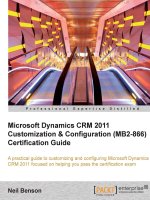
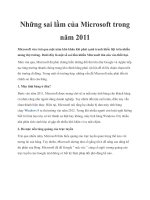

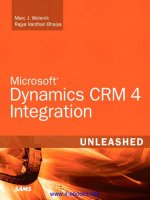
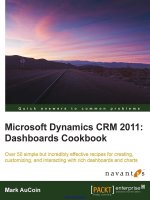
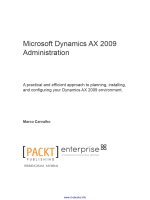
![maximizing your sales with microsoft dynamics crm 2011 [electronic resource]](https://media.store123doc.com/images/document/14/y/ir/medium_irp1401358930.jpg)